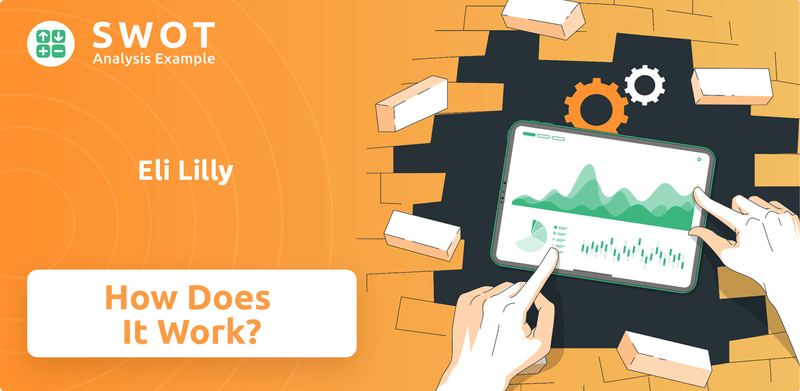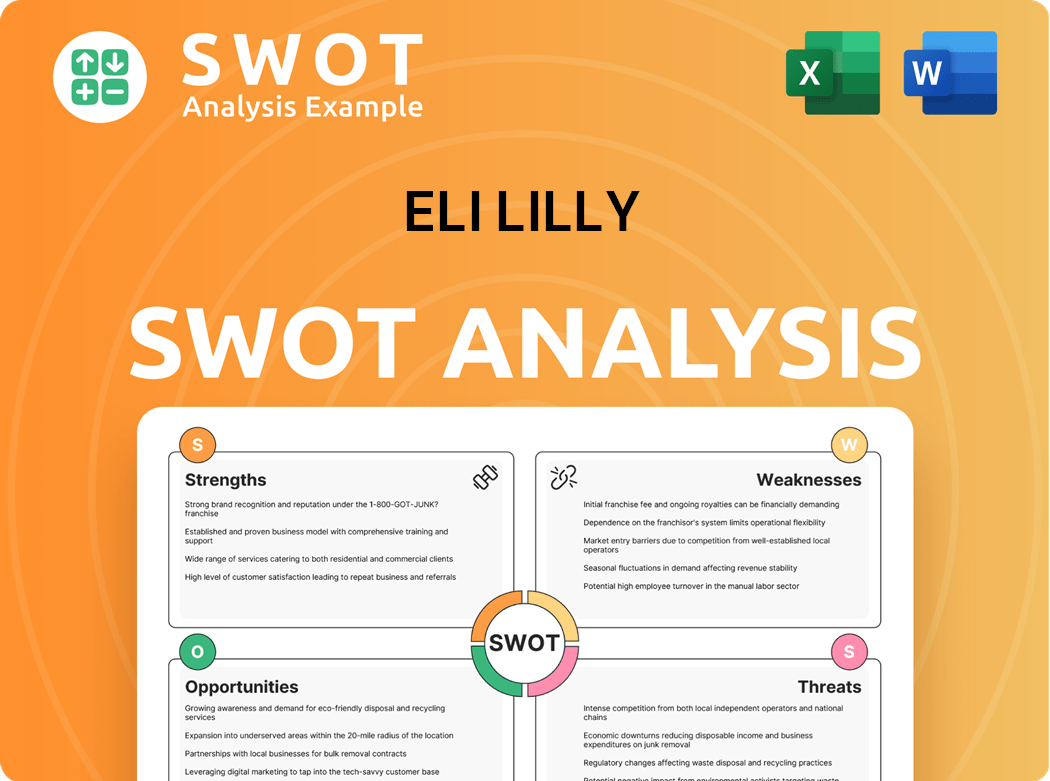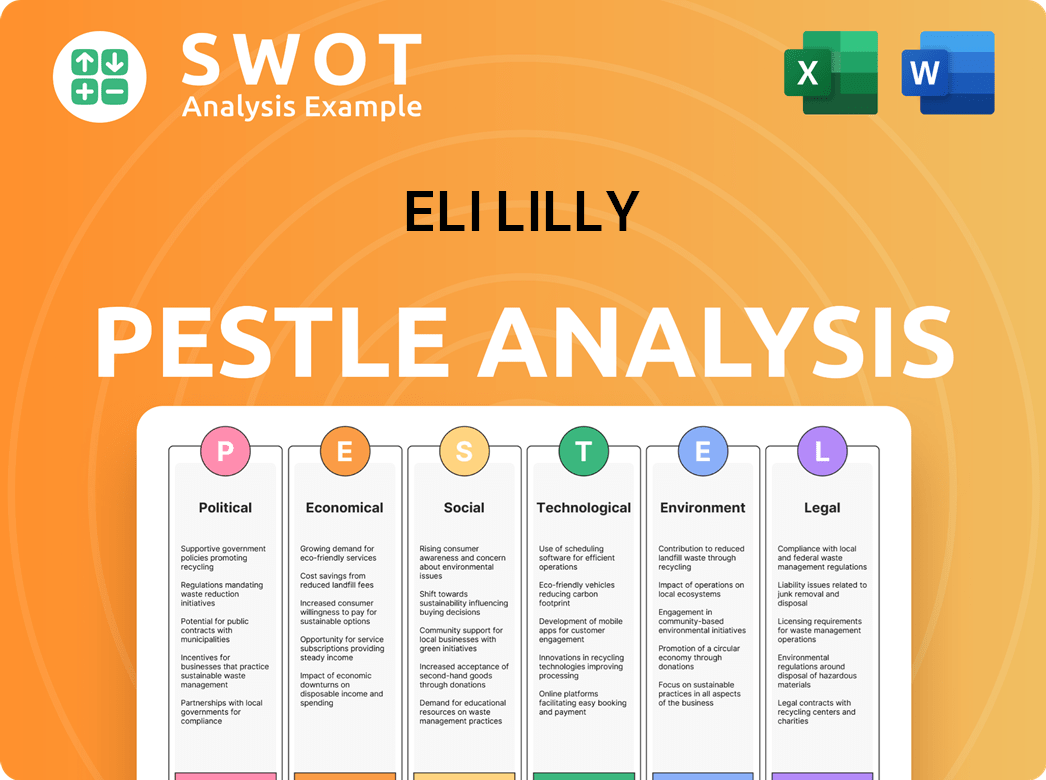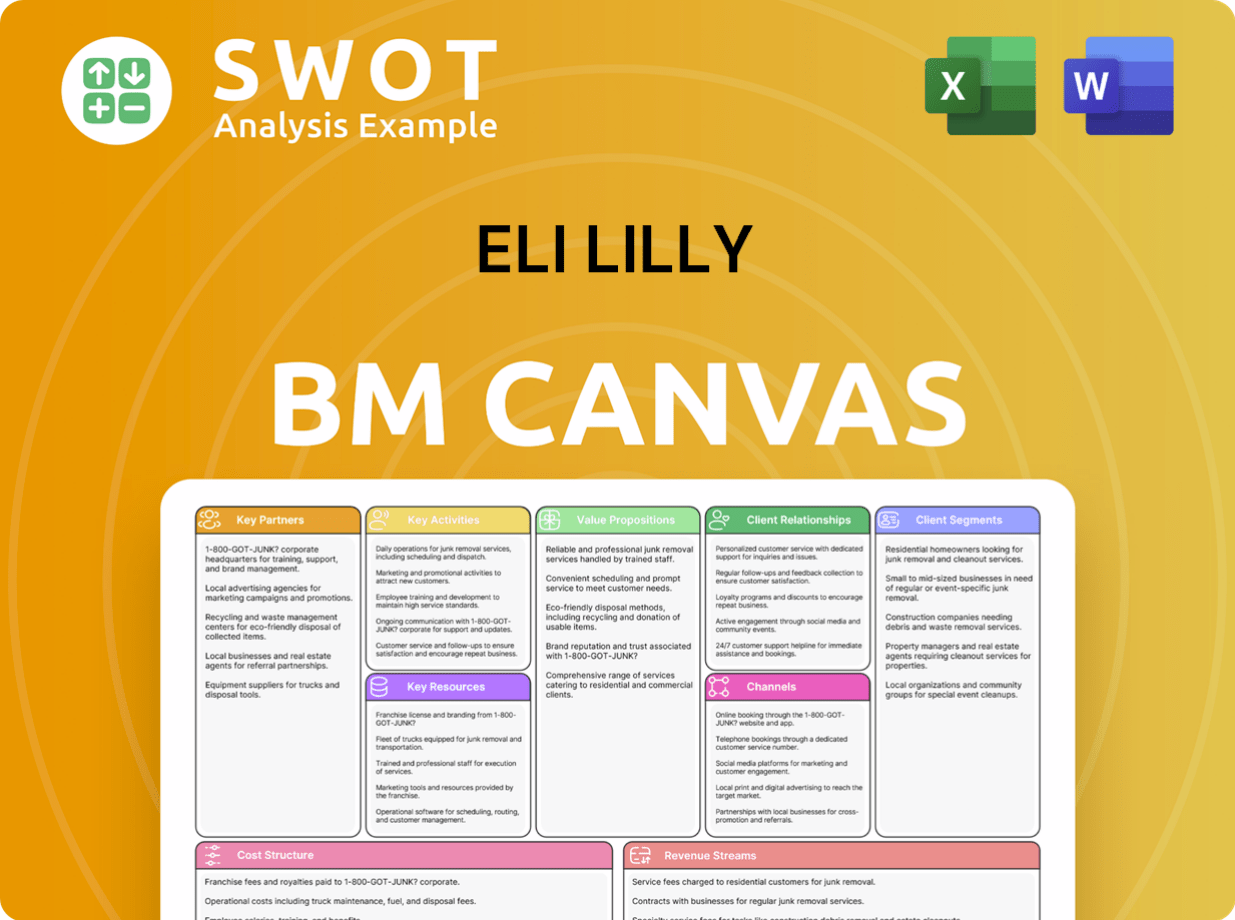Eli Lilly Bundle
Can Eli Lilly Company Continue Its Pharmaceutical Dominance?
Eli Lilly and Company, a titan in the Eli Lilly SWOT Analysis, is reshaping the healthcare landscape with its innovative therapies and impressive financial performance. With a staggering $45.0 billion in worldwide revenue in 2024 and a projected surge to $58.0-$61.0 billion in 2025, the Lilly company is experiencing explosive growth, primarily fueled by its groundbreaking treatments for diabetes and obesity. This remarkable trajectory makes understanding Eli Lilly's operations essential for anyone invested in the future of the pharmaceutical industry.

This exploration into Eli Lilly Company delves beyond the headlines to uncover the core strategies driving its success. We'll examine how this Lilly company generates revenue, its strategic milestones, and the competitive advantages that position it as a market leader. Whether you're curious about the company's drug development processes, the impact of Lilly products, or the potential of Eli Lilly and diabetes treatments, this analysis offers critical insights into one of the world's leading pharmaceutical companies.
What Are the Key Operations Driving Eli Lilly’s Success?
The core operations of the Eli Lilly Company involve the discovery, development, manufacturing, and marketing of pharmaceutical products. These products span various therapeutic areas, including diabetes, obesity, cancer, immunology, and neuroscience. The company's focus on innovation and strategic partnerships is key to its success in the pharmaceutical industry.
The value proposition of Lilly pharmaceuticals lies in its ability to provide breakthrough treatments for widespread and debilitating conditions. Key products like Mounjaro and Zepbound have been pivotal in addressing chronic diseases, with Mounjaro generating $3.5 billion in sales in Q4 2024 and Zepbound bringing in $1.9 billion during the same period. This commitment to innovation and patient care differentiates Lilly company in the market.
The operational processes include extensive research and development (R&D), manufacturing, and a robust global distribution network. Eli Lilly Company continues to invest heavily in increasing its manufacturing capacity to meet the surging demand for its incretin doses, expecting to produce at least 1.6 times more salable incretin doses in the first half of 2025 compared to the first half of 2024. The company's supply chain has faced disruptions due to high demand, leading to previous shortages of tirzepatide, the active ingredient in Mounjaro and Zepbound. However, significant manufacturing investments have helped alleviate these issues.
Mounjaro and Zepbound, both GLP-1 receptor agonists, have seen soaring popularity due to their effectiveness in weight management and diabetes treatment. Verzenio for breast cancer and Jardiance for diabetes are also significant contributors to the company's revenue. These products demonstrate Lilly products' impact on patient health.
Eli Lilly engages in strategic partnerships, such as its collaboration with Boehringer Ingelheim for Jardiance. The company is also actively involved in business development transactions, including the pending acquisition of Scorpion Therapeutics, Inc.'s mutant-selective PI3Kα inhibitor program. These moves help expand its pipeline.
Eli Lilly allocates a significant portion of its resources to research and development, with 24% of sales allocated to it in 2024. This commitment allows for the continual development of innovative therapies. Investments in manufacturing capacity are also crucial to meeting the growing demand for its products.
The company's dominant positioning in certain disease areas, particularly with its GLP-1 drugs, and its expertise in manufacturing, set it apart. The focus on core capabilities translates into significant customer benefits, offering breakthrough treatments for widespread and debilitating conditions. Read more about the Growth Strategy of Eli Lilly.
Eli Lilly's operational success hinges on its robust R&D, efficient manufacturing, and strategic partnerships. These processes ensure the company can deliver innovative therapies and meet market demands. The company's focus on these areas has allowed it to maintain a strong position in the market.
- Extensive Research and Development (R&D)
- Manufacturing Capabilities and Capacity Expansion
- Strategic Partnerships and Business Development
- Global Distribution Network
Eli Lilly SWOT Analysis
- Complete SWOT Breakdown
- Fully Customizable
- Editable in Excel & Word
- Professional Formatting
- Investor-Ready Format

How Does Eli Lilly Make Money?
The primary revenue stream for the Eli Lilly Company comes from the sale of its pharmaceutical products. The company's financial success is heavily influenced by the performance of its key drugs and its ability to expand market access for its therapies.
In Q4 2024, the Lilly pharmaceuticals reported a significant surge in worldwide revenue, increasing by 45% to $13.53 billion. For the full year 2024, worldwide revenue reached approximately $45.0 billion, marking a 32% increase compared to 2023. This growth is driven by successful product launches and expanded indications.
Looking ahead, the company anticipates revenue between $58.0 billion and $61.0 billion for 2025, reflecting an approximate 32% growth compared to 2024. This projection is fueled by new medicines and expanded indications, highlighting the company's ongoing growth trajectory. For more insights, check out the Growth Strategy of Eli Lilly.
The success of Eli Lilly Company is largely dependent on its top-performing products, especially Mounjaro and Zepbound. The company's monetization strategies include direct product sales and expanding market access. The company is also focused on launching Mounjaro in additional worldwide markets and exploring new therapeutic indications.
- In Q4 2024, Mounjaro sales increased by 60% to $3.53 billion, and Zepbound generated $1.9 billion.
- In Q1 2025, Mounjaro revenue was $3.84 billion, and Zepbound revenue was $2.31 billion.
- Non-incretin revenue grew by 20% in Q4 2024, with strong performances from oncology, immunology, and neuroscience medicines.
- The breast cancer treatment Verzenio contributed $1.55 billion in Q4 2024, and Jardiance saw a 50% increase in worldwide revenue, reaching $1.20 billion in Q4 2024.
- The company's gross profit margin was an impressive 80.9% in 2024.
Eli Lilly PESTLE Analysis
- Covers All 6 PESTLE Categories
- No Research Needed – Save Hours of Work
- Built by Experts, Trusted by Consultants
- Instant Download, Ready to Use
- 100% Editable, Fully Customizable

Which Strategic Decisions Have Shaped Eli Lilly’s Business Model?
The recent operational and financial performance of the Eli Lilly Company has been significantly shaped by key milestones and strategic moves. The company, a major player in the pharmaceutical industry, has demonstrated strong growth, particularly in its diabetes and obesity treatments. This performance reflects strategic decisions and investments in research and development, as well as responses to market demands and regulatory approvals.
One of the most significant drivers of Lilly pharmaceuticals success has been its GLP-1 drugs, Mounjaro and Zepbound. These drugs have not only boosted revenue but also led to expanded market opportunities. Furthermore, the company has been actively expanding its manufacturing capabilities to meet the increasing demand for its products, addressing supply chain challenges and ensuring product availability. This proactive approach highlights the company's commitment to meeting patient needs and capitalizing on market opportunities.
The company's strategic focus on innovation and its ability to adapt to market dynamics are crucial for its competitive edge. Eli Lilly has consistently invested in R&D, ensuring a robust pipeline of innovative therapies. The company's ability to navigate regulatory approvals, manage supply chain complexities, and strategically expand its product portfolio positions it for continued success in the pharmaceutical market. For a look at the company's origins, check out the Brief History of Eli Lilly.
A key milestone was the strong performance of Mounjaro and Zepbound, boosting revenue by 45% in Q4 2024 to $13.53 billion. Zepbound received U.S. FDA approval for moderate-to-severe obstructive sleep apnea in adults with obesity in Q4 2024. The launch of Kisunla in China for early symptomatic Alzheimer's disease also marked a significant achievement.
The company has invested billions in expanding manufacturing capacity, aiming to produce at least 1.6 times more salable incretin doses in the first half of 2025 compared to the first half of 2024. Legal action was taken against companies selling unauthorized compounded versions of its weight loss drugs. Strategic acquisitions, such as the pending acquisition of Scorpion Therapeutics' mutant-selective PI3Kα inhibitor program, also enhance growth.
Eli Lilly's competitive advantages include a strong patent-protected drug portfolio, particularly in the GLP-1 class, providing pricing power. The company allocated 24% of sales to R&D in 2024, ensuring a robust pipeline. It maintains a strong brand and diversified product portfolio across therapeutic areas. The company is also exploring oral GLP-1 therapies like orforglipron, which showed positive Phase 3 trial results for Type 2 diabetes.
The company faced supply chain disruptions and high demand for incretin drugs. Tirzepatide, the active ingredient in Mounjaro and Zepbound, was in shortage for two years until December 19, 2024. These challenges prompted significant investment in manufacturing capacity to meet growing market needs and address supply constraints.
Eli Lilly's success is driven by strong performance in the GLP-1 market, strategic investments in manufacturing, and a robust R&D pipeline. The company's ability to navigate regulatory approvals and address supply chain challenges is critical. The company's focus on innovation and its diversified portfolio position it well for future growth.
- Strong GLP-1 drug performance and market expansion.
- Significant investments in manufacturing to meet demand.
- Consistent R&D spending to fuel innovation.
- Strategic acquisitions to enhance the pipeline.
Eli Lilly Business Model Canvas
- Complete 9-Block Business Model Canvas
- Effortlessly Communicate Your Business Strategy
- Investor-Ready BMC Format
- 100% Editable and Customizable
- Clear and Structured Layout

How Is Eli Lilly Positioning Itself for Continued Success?
The Eli Lilly Company holds a prominent position within the global pharmaceutical industry, particularly excelling in diabetes and obesity treatments. Its success is largely attributed to blockbuster drugs like Mounjaro and Zepbound. In the competitive U.S. market for incretin analogs, Lilly pharmaceuticals leads with a 53.3% market share, surpassing Novo Nordisk's 46.1%.
Despite its strong market presence, Eli Lilly Company encounters various challenges. Competition from companies like Novo Nordisk, regulatory hurdles, and pricing pressures, including U.S. inflation-reduction policies, pose significant risks. The company also faces litigation risks related to pricing and product liability. Patent expirations represent an ongoing industry-wide pressure, though less immediate for Lilly due to its robust pipeline. Operational risks, such as supply chain issues, could disrupt drug distribution.
Lilly's leadership is evident in its market share within the incretin analogs segment and its diverse product portfolio. The company's products are strong in oncology, immunology, and neuroscience. This diversification helps mitigate risks and ensures a broad revenue base.
Intense competition, especially from Novo Nordisk, poses a significant threat. Regulatory hurdles, including pricing pressures and potential price caps, could affect profitability. Litigation related to pricing and product liability adds to the challenges. Supply chain disruptions could also impact drug distribution.
Eli Lilly Company anticipates growth driven by new medicines, including Jaypirca, Ebglyss, Omvoh, and Kisunla. Expansion of existing drugs, like Mounjaro, into new global markets will contribute to revenue. Strategic investments in manufacturing capacity will also support growth.
The company projects 2025 revenue to be between $58.0 billion and $61.0 billion, a 32% increase at the midpoint compared to 2024. This growth will be supported by new product launches, expanded market reach, and increased manufacturing capacity. Strategic investments in R&D will also play a key role.
Lilly is heavily investing in manufacturing, planning to produce at least 1.6 times more salable incretin doses in the first half of 2025 compared to the first half of 2024. The company has announced investments in four new manufacturing facilities in the U.S. The R&D pipeline continues to deliver promising results, such as the oral GLP-1 treatment orforglipron in Phase 3 trials for type 2 diabetes. To learn more about the financial performance of Eli Lilly Company, explore Owners & Shareholders of Eli Lilly.
- Focus on innovation and market expansion.
- Strategic investments in manufacturing to meet growing demand.
- Continued development of a robust R&D pipeline.
- Expansion into new global markets.
Eli Lilly Porter's Five Forces Analysis
- Covers All 5 Competitive Forces in Detail
- Structured for Consultants, Students, and Founders
- 100% Editable in Microsoft Word & Excel
- Instant Digital Download – Use Immediately
- Compatible with Mac & PC – Fully Unlocked

Related Blogs
- What are Mission Vision & Core Values of Eli Lilly Company?
- What is Competitive Landscape of Eli Lilly Company?
- What is Growth Strategy and Future Prospects of Eli Lilly Company?
- What is Sales and Marketing Strategy of Eli Lilly Company?
- What is Brief History of Eli Lilly Company?
- Who Owns Eli Lilly Company?
- What is Customer Demographics and Target Market of Eli Lilly Company?
Disclaimer
All information, articles, and product details provided on this website are for general informational and educational purposes only. We do not claim any ownership over, nor do we intend to infringe upon, any trademarks, copyrights, logos, brand names, or other intellectual property mentioned or depicted on this site. Such intellectual property remains the property of its respective owners, and any references here are made solely for identification or informational purposes, without implying any affiliation, endorsement, or partnership.
We make no representations or warranties, express or implied, regarding the accuracy, completeness, or suitability of any content or products presented. Nothing on this website should be construed as legal, tax, investment, financial, medical, or other professional advice. In addition, no part of this site—including articles or product references—constitutes a solicitation, recommendation, endorsement, advertisement, or offer to buy or sell any securities, franchises, or other financial instruments, particularly in jurisdictions where such activity would be unlawful.
All content is of a general nature and may not address the specific circumstances of any individual or entity. It is not a substitute for professional advice or services. Any actions you take based on the information provided here are strictly at your own risk. You accept full responsibility for any decisions or outcomes arising from your use of this website and agree to release us from any liability in connection with your use of, or reliance upon, the content or products found herein.